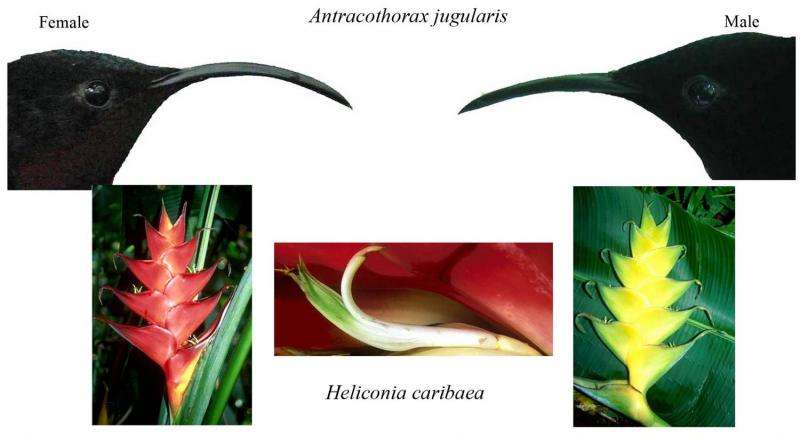Pollinator competition may drive flower diversification

Male hummingbirds drive female birds away from their preferred yellow-flowered plant, which may have implications for flower diversification, according a study published Jan. 27, 2016 in the open-access journal PLOS ONE by Ethan Temeles from Amherst College, and colleagues.
Scientists suggest that competition between two different pollinators for the same flower species could drive the plant to evolve into multiple forms. To understand one potential mechanism behind this theory, Temeles and colleagues examined purple-throated carib hummingbirds' behavior and preference when pollinating red or yellow 'lobster claw' plants, a tropical flower species. In an enclosed outdoor garden, the lobster claw flowers were outfitted with a pollen-like fluorescent dye and researchers counted the dye particles transferred to different lobster claw plants by male and female birds alone and in completion.
The researchers found that when foraging alone male hummingbirds preferred the yellow flowers and female hummingbirds showed no color preference. When in competition, the males still preferred visiting plants with yellow flowers, but females tended to visit the plants with red flowers instead, due to aggression from males over the yellow flowers. Shorter-billed male hummingbirds transferred more dye particles to flowers of intermediate length, whereas longer-billed females transferred more dye particles to long flowers. The authors suggest that based on these results, hummingbird flower preference could be a mechanism driving plant diversification to suit different pollinators. Although the experiment was conducted in an artificial environment, the researchers suggest it may exemplify how competition between pollinators could be a mechanism driving and maintaining diverse flower forms.
Ethan Temeles notes that these experiments "demonstrate that competition between two different kinds of hummingbirds can result in resource partitioning and natural selection for divergence in flowering plants."
More information: Temeles EJ, Newman JT, Newman JH, Cho SY, Mazzotta AR, Kress WJ (2016) Pollinator Competition as a Driver of Floral Divergence: An Experimental Test. PLoS ONE 11(1): e0146431. DOI: 10.1371/journal.pone.0146431
Journal information: PLoS ONE
Provided by Public Library of Science



















